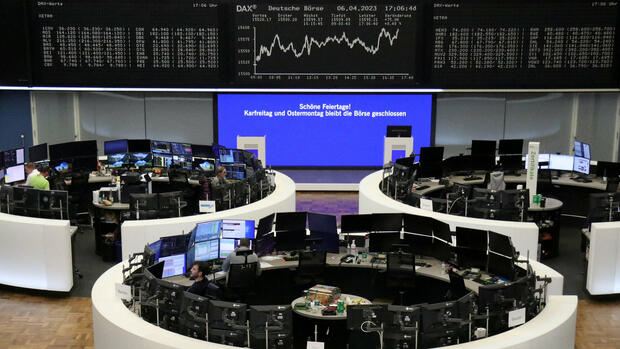If the dividends are deducted, the Dax has hardly risen in recent years.
(Photo: Reuters)
With just over 15,700 points, the Dax rose to its highest level in more than a year in the week before Easter. Three and a half percent are still missing until the all-time high. How can that be, given the major crises, starting with the war in Ukraine, continuing through rising prices and interest rates to concerns about a new banking crisis?
A closer look shows that the profits were by no means as great as the almost all-time high would have you believe. At least not if investors have invested their money for the long term and have put their money on the Dax, for example in the form of an ETF.
Since the year 2000, almost all profits from the Dax have been based solely on dividends, which most corporations transfer to their shareholders once a year. This is shown by the “pure”, genuine Dax. It only includes price gains, but no dividends – as is usual in almost all other stock market indices, including the Euro Stoxx 50, Dow Jones, Nasdaq and S&P 500.
Since the year 2000, this course Dax has gained just five percent. This corresponds to an average annual interest rate of 0.2 percent. In the last five years, there has been a loss of 1.4 percent per year.
Those who avoided the Dax and instead invested their money in solid government or corporate bonds will achieve higher asset growth – and without any nerve-wracking price fluctuations.
Corporate profits and profitability have come under pressure
Now it can be argued that dividends have to be factored in, after all they are part of the stock. That is correct, but the annual distributions must be taxed at 25 percent above an exemption limit of 1000 euros. Plus church tax and solidarity surcharge, around 30 percent goes to the state.
>> Read here: “Bank stocks are more of a buy than a sell”
In addition, the annual dividends only flow into the long-term total profit if they are not spent on other things, but are immediately reinvested in the Dax after being transferred to the custody account. This is exactly what the stock exchange does as an index operator with the performance Dax we know, which has just risen to an annual high.
But even this Dax is not as successful over the year as the five-digit number of points with the almost record high would suggest. Since the year 2000, an average interest rate of three percent has been calculated per year, and in the last five years it has even been only one and a half percent. This corresponds to returns that are currently possible with call money.
The meager yield leads to the conclusion that the Dax has given us two lost decades. In addition to the financial and economic crisis in 2008/09, the reason for this may be the problems outlined above.
Companies cannot pass on costs
Rapidly rising prices combined with pent-up inventories make it difficult for many DAX companies to pass on higher costs to customers, putting profits and profitability under pressure. This was recently pointed out by the sporting goods manufacturer Puma and the pharmaceutical company Bayer.
In addition, rising interest rates weigh on future corporate profits and dividends because companies need more money for their debt. After all, the high gas and electricity prices are a problem, especially for energy-intensive companies such as BASF and Covestro, because production, at least in Germany, is becoming less and less economical.
In this respect, the sobering conclusion applies: Without these burdens, the Dax would probably have been in a better position and would have given us higher returns.
More: Dax beats Dow & Co. – in the long term it looks the other way around
